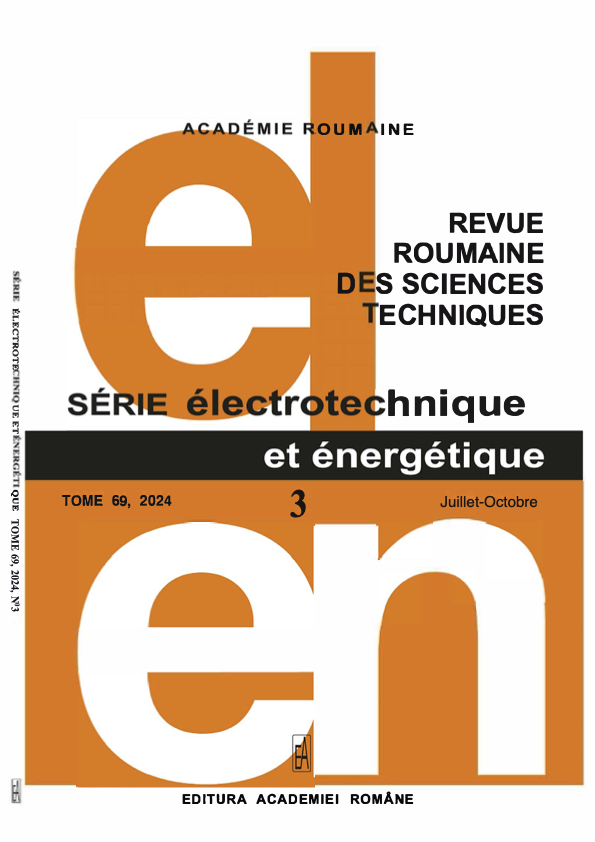MITIGATION OF POWER QUALITY PROBLEMS IN STEEL PLANTS USING STATIC SYNCHRONOUS COMPENSATOR
DOI:
https://doi.org/10.59277/RRST-EE.2024.69.3.6Keywords:
Electrical arc furnace (EAF), Flicker, Fuzzy logic controller (FLC), Harmonics, Power quality, Static synchronous compensator (STATCOM), Steel plantAbstract
This paper focuses on mitigating various power quality issues from electric arc furnaces (EAF) in steel plants, including voltage flicker, sag, swell, and harmonics. Arc furnaces are recognized as one of the industry's most nonlinear electrically polluting loads. The proposed solution in this article to address all power quality issues caused by EAF is implementing a flexible power supply strategy known as a static synchronous compensator (STATCOM) for injecting reactive energy into the electrical grid. In this study, an experimental model of EAF is utilized based on real measurements of the variation of arc resistance and arc reactance during the melting phase. The pulse width modulation (PWM) technique is employed for current tracking feedback control to generate the required reactive current. A fuzzy logic controller (FLC) is employed for the DC bus.
References
(1) N. Daou, H.F. Fassi, N. Ababssi, Y. Djeghader, Minimum variance control of active filter for reduction of harmonics, Revue Roumaine des Sciences Techniques série Électrotechnique et Énergétique, 6, 4, pp. 391–395 (2019).
(2) H. Samet, S. Gashtasbi, N. Tashakor, T. Ghanbari, Improvement of reactive power calculation in electric arc furnaces utilising Kalman filter, Science Measurement & Technology IET, 11, 3, pp. 241–248 (2017).
(3) R. Hooshmand, M. Banejad, M-T. Esfahani, A new time domain model for electric arc furnace, Journal of Electrical Engineering, 59, 4, 195–202 (2008).
(4) G.C. Lazaroiu, D. Zaninelli, A control system for DC arc furnaces for power quality improvements, Electric Power Systems Research, 80, 12, pp. 1498–1505, 2010.
(5) Y. Varetsky, V. Konoval, M. Seheda, O. Pastuh, Studying voltage fluctuations in microgrid with hybrid renewable energy system, Proc. IEEE 6th Int. Conf. on Energy Smart Systems, pp. 239-242 (2019).
(6) H. Samet, A. Mojallal, T. Ghanbari, Employing grey system model for prediction of electric are furnace reactive power to improve compensator performance, Przeglad Elektrotechniczny, 89, pp. 110–115 (2013).
(7) H. Labar, Y. Djeghader, K.Bounaya, M-S. Kelaiaia , Improvement of electrical arc furnace operation with an appropriate model, Journal Energy, Elsevier, 34, pp. 1207–1214 (2009).
(8) Y. Djeghader, H. Labar, K.Bounaya, Modelling and parametrical approximation of an electric arc furnace steelmaking, Journal of Electrical Engineering (JEE), 9, 3, pp. 25–30 (2009).
(9) Y. Djeghader, H. Labar, K. Bounaya, Analysis of harmonics generated by different structures of a DC EAF, International Review of Modelling and Simulations (IREMOS), 1, 1, pp. 173–177 (2008).
(10) S. Arockiaraj, B.V. Manikandan A. Bhuvanesh, Fuzzy logic controlled STATCOM with a series compensated transmission line analysis, Rev. Roum. Sci. Techn. – Électrotechn. Et Énerg., 68, 3, pp. 307–312 (2023).
(11) M. Gavrilas, R. Toma, Flexible alternating current transmission system optimisation in the context of large disturbance voltage stability, Rev. Roum. Sci. Techn. – Électrotechn. Et Énerg., 66, 1, pp. 21–26 (2021).
(12) H. Akagi, Y. Kanazawa, A. Nabae, Instantaneous reactive power compensators comprising switching devices without energy storage components, IEEE Trans. on Industry Applications, 20, 3, pp. 625–630 (1984).
(13) S. Saad, L. Zellouma, Fuzzy logic controller for three-level shunt active filter compensating harmonics and reactive power, Elesevier, Electric Power Systems Research, 79, pp 1337–1341 (2009).
(14) N. Zidane, S.L. Belaid, A new fuzzy logic solution for energy management of hybrid photovoltaic /battery/hydrogen system, Rev. Roum. Sci. Techn. – Électrotechn. Et Énerg., 67, 3, pp. 21–26 (2022).
Downloads
Published
Issue
Section
License
Copyright (c) 2024 REVUE ROUMAINE DES SCIENCES TECHNIQUES — SÉRIE ÉLECTROTECHNIQUE ET ÉNERGÉTIQUE

This work is licensed under a Creative Commons Attribution-NonCommercial-NoDerivatives 4.0 International License.


